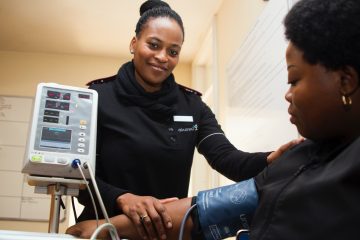Dr. Preeti Shakya is a medical doctor from Nepal who founded Project “In Her Hands” in 2017 with an aim to destigmatize menstruation and normalize conversations around it. In this interview, she tells us about what led to starting this initiative and how it’s like working with the local community.
1. What are the main goals of the project to destigmatize menstruation ‘In Her Hands’?
Menstruation is still a taboo subject in many developing countries like Nepal and spoken in hushed conversations. The project “In her hands” was initiated with an aim to start conversations around menstruation and to destigmatize it via:
- Advocacy campaigns on Menstrual Hygiene Management (MHM)
- Focused group discussions
- Facilitating access to sanitary hygiene materials and physical infrastructures like female friendly toilets and safe water sources
- Capacity building activities for adolescent girls
We are working towards ensuring that girls have a voice in their communities so that their menstrual hygiene needs are taken into account.
2. What made you want to start this project to fight menstruation stigmatization?
Three years back, during a medical project trip to a remote area in Nepal, I came across an age-old tradition of banishing women from their homes to live in sheds during the time, they were menstruating as a part of the customary practice known as ‘Chhaupadi pratha’. Chhaupadi – which is based upon the belief that menstruating women are impure – prohibits menstruating women and girls from inhabiting any public space and socializing with others.
Despite being outlawed by the Nepalese Supreme Court in 2017, Chhaupadi retains a foothold in the country’s western region and continues to put constraints on the potential, action and participation of women.
Managing menstruation in resource-poor settings is often challenging. Buying a sanitary napkin is a luxury most rural women can’t afford, and so many end up using cloths, rags and – in extreme cases – straw, sand, or even ash as menstrual absorbents. More than a quarter of women have been forced to miss work or school because they cannot afford period products. Too many people cannot pay for them at all and are often torn between purchasing food or menstrual supplies.
Poor menstrual hygiene can cause physical health risks and has been linked to reproductive and urinary tract infections and even death, in extreme cases. It also stops women from reaching their full potential when they miss out on opportunities crucial to their growth.
The plight of these vulnerable women deeply motivated me to take action and break the silence around menstruation, hence, I founded Project ‘In Her Hands’.
3. When was the project founded and who are the stakeholders or donors of this project?
The project began as a self-funded initiative in 2017. The key stakeholders are adolescent girls and young women. The other stakeholders include family members including boys/men, older women, NGOs/INGOs, local/community youth organizations, local/provincial government officials, policymakers, teachers, local community and religious leaders, health workers, industrialists/business houses, media etc.
4. How big is your team for this project?
We are a team of 10-15 people at the moment.
5. How do you promote menstrual hygiene management in a culturally sensitive and appropriate way? How do you gain public support and enact behavior change when this practice is so rooted in tradition and “cultural norms?”
Most of the menstrual taboos and stigmas stem from culture and religion. Therefore, it is very essential to explore a community’s cultural values and incorporate them into the design, implementation and evaluation of community projects. In such a setting, local and religious leaders of the communities can play an elemental role in acting as change agents in the elimination of harmful and traditional practices as they have a strong influence in their communities. A tool that came really handy to sensitize the community members was adaptation of educational resources into their native language which promoted better understanding. The use of creative tools like audio-visual tools like storytelling, drama, music, arts, etc. can enhance better community engagement.
6. How can one get involved in the project or in menstruation destigmatization in general?
One can get involved in our cause by either advocating, or becoming an ally. It starts by initiating a conversation around menstruation and it begins in our households and then communities. It’s important to address the shame and stigma associated with the topic of menstruation and encourage conversations around it.
7. How does menstrual hygiene management in Nepal compare to other countries in the region? Other lower/middle-income countries? And the world?
Like many other lower/middle income countries, Nepal still grapples with a lot of shame and stigma around the topic of menstruation. Period poverty is rampant as many girls/women struggle to choose between a meal and a sanitary napkin and the COVID 19 pandemic has only deepened it. Furthermore, Nepal continues to be one of the many countries that imposes a 13% value added tax (VAT) on menstrual products. This sales tax increases the cost of menstrual products significantly—hindering affordable access and treating these essential goods as luxury items.
8. Is the Nepalese government doing anything to promote better menstrual hygiene management? If yes, what? If not, why?
Chhaupadi was outlawed by the Supreme Court of Nepal in 2005, but the tradition has been slow to change. In 2017, Nepal passed a law punishing people who forced women into exile during menstruating with up to three months in jail or a fine of 3,000 Nepalese rupees.
Similarly, last year, the Government of Nepal allocated 1.82 billion rupees for the purchase and distribution of free sanitary pads to the approximately 29,000 government aided schools in Nepal. The particular investment intends to benefit more than 1.3 million girls in the country and to minimize student absenteeism and create a conducive learning environment for girls. The pads will be made available to girls in grade 7 through 12 and each girl will be allocated 16 pads per month.
In addition, technical support and training on menstrual hygiene management has been extended to the teachers, girls of grade 7 to 12, and sanitation workers across schools in Kathmandu.
9. Since the start of this project have you achieved any indicators or reached any benchmarks to evaluate improvements on this health issue? What in your opinion are the biggest accomplishments and setbacks of this project?
Since our pilot project in Janakpur, we have managed to impact the lives of about 1500 women. We used a semi structured questionnaire to collect the qualitative data that captured the experiences and perceptions of respondents on MHM prior and post completion of the project. As a result, there was a 35% increase in the knowledge, attitude and practice of the community members regarding MHM. We were able to curb school absenteeism by 40% and bring about a 20% increase in the access of MHM materials and physical infrastructures. One of the biggest setbacks we faced was the cultural resistance as taboos, stigma, and shame around menstruation are highly entrenched in some of the communities. Capital access also remained one of the major challenges.
10. How is the healthcare system structured in Nepal? In a typical rural community?
The federal republic of Nepal is divided into three levels of governance: the central, the provincial, and the local government. A typical rural community is governed by a local government that is either a municipality or rural municipality. The constitution of Nepal has provisions for the local government to formulate its own health regulations in accordance with the local needs. A typical rural municipality has under its helm either one of these health institutions: a health post, a primary health center or a primary hospital.
The most important bridge between the community and the local health system are the Female Community Health Volunteers (FCHVs). These women, chosen by the local mothers’ group with the recommendation of the local health section, have basic medical training but are integral during community outreach. They have close ties with everyone in the community, are easily accessible, and are vital for community outreach. Along with other trained health personnel, FCHVs can help disseminate vital health information, collect health data, and recognize the ones who need health care. It is common for rural communities to not even have a single doctor working for them.
In terms of menstrual health, the FCHVs and the local government have multiple programs to promote proper menstrual practices. The local government has multiple outreach programs to teach the community at large against menstrual ostracism. There are programs for school going girls to teach them about better menstrual hygiene practices. The local government distributes free sanitary pads. It also runs campaigns to provide school aged girls with iron capsules and albendazole tablets (with the help of FCHVs) to prevent anemia which can be exacerbated by increased blood losses during menses. The provincial and central governments support these endeavours of the local government by providing financial and technical assistance.
11. Is it common to have health care providers that speak the local language in the different regions of Nepal?
Yes, it’s very common for the local health care providers in Nepal to speak the local language of the regions that they are serving. Nepal is a multilingual country with over 123 languages being spoken over the country. Hence, for healthcare professionals, it’s not uncommon to encounter patients whose native languages are different from their own. This linguistic diversity could serve as an important tool as a fundamental means of communication and building interpersonal relationships with the locals. In addition to that, multilingual professionals have the opportunity to connect with their patients in a more meaningful way, helping to provide a more comfortable experience and a better quality of care by communicating in a way the patient can fully understand.

12. What do you think are the most important reasons to promote menstrual hygiene management?
Lack of period supplies can force people to resort to unhygienic and unsafe practices to manage their monthly cycle. Poor menstrual hygiene practices can impose various health implications on girls and women such as reproductive and urinary tract infections. Shame and stigma around menstruation often prevent girls and women from developing healthy relationships with their bodies, as a result of which many tend to develop self esteem issues and fail to recognize it as a public health issue. Thus, the promotion of MHM is an important step towards safeguarding the health, dignity, bodily integrity, and overall life opportunities of women and girls.
13. What have been the improvements in menstrual hygiene management around the world? How were these improvements made?
In the recent years, there have been a lot of policy changes and investments around MHM around the world. Scotland has become the first country to provide free access to period products to all those who need them. Since 2004, many countries have abolished or reduced sales taxes for tampons and pads including Kenya, Canada, India, Columbia, Australia, Germany, and Rwanda facilitating the access of these materials. Similarly, many other countries in the world are also lobbying the policymakers for the same.
Various organizations like USAID, UNICEF, UNFPA, UMN, Save the Children, Oxfam, Plan International, Water Aid, etc are relentlessly working with host governments to draft national MHM strategies. These organizations have been creating educational resources, developing design standards for female-friendly facilities, promoting the availability of MHM related supplies and destigmatizing menstruation around the world. A lot of innovations are taking place around MHM and various sustainable period options have now been introduced.
14. What women are at the greatest risk of suffering from poor menstrual hygiene management and what is the best way to reach this population?
Women with financial constraints, women living in the rural communities, women with disabilities, and vulnerable women are at the greatest risk of suffering from poor menstrual hygiene management. Their needs are currently under-represented in MHM programming and interventions. The best way to reach out to these populations is applying an inclusive approach and taking their needs into account while designing, implementing, monitoring, and evaluating MHM programmes.
15. Are men included in this project or cause in general considering the root of this problem stems from patriarchal customs and culture? If yes, how so?
Most of the menstrual hygiene challenges are rooted in gender inequality. Unequal power relations between men and women result in women’s and girls’ voices not being heard in decision-making within households, and communities. Therefore, men are responsible for decision-making regarding facilities and services needed by women and girls, including access to toilets and the availability of sanitary napkins, and women and girls’ participation in awareness raising sessions and community meetings.
Men and boys can support women and girls to manage menstruation effectively across different social domains including household, community, school, and work. Men and boys influence women’s and girls’ experiences of MHM through many roles, including as husbands, fathers, brothers, students, peers, teachers, community leaders, entrepreneurs, employers, development and humanitarian practitioners, and policymakers.
Thus as a part of our initiative, we have established separate groups for boys and men of the communities. Focused group discussions are held to assess the existing knowledge, attitudes, myths, and practices around MHM and to sensitize them on WASH, gender, and MHM. Community meetings are held involving school, teachers, youths in and out of school, and elderly men in community. Male members of school management committees are also involved through training and awareness-raising sessions to provide supportive environments for effective MHM in schools and to inspire men to become harbingers of change.
For any programme that is focused on community awareness, it is always essential to sensitize all stakeholders for effective results. An inclusive approach where men are equal partners ensures greater support and leads to successful empowerment of the whole community especially women and girls. The involvement of men and boys through creating spaces for open dialogue has enabled men and boys to realize the importance of MHM as well as issues of reproductive health, women’s self-esteem, and empowerment.
16. Where do you see the project going in the next few years?
We intend to extend the outreach of our programme in other areas of dire need where the tradition of chhaupadi is rampant. We also intend to set up the sanitary pads manufacturing units in these places and start the production of sustainable sanitary napkins. We will continue to lobby the policymakers to remove sales tax on menstrual hygiene products.




0 Comments